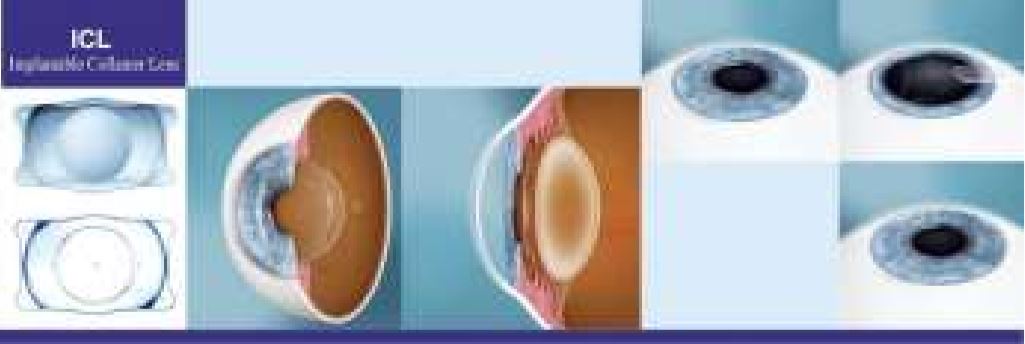Frequently Asked Questions on ICL (Implantable Collamer Lens)
Implantable Collamer Lens or ICL is a new intraocular lens that can be implanted into the eye without removing the natural lens. This lens is an excellent choice for patients with short-sightedness (myopia), long-sightedness (hyperopia) and astigmatism. This lens is made from a material called collamer, a collagen co-polymer that contains a small amount of purified collagen. Since it is stable and biocompatible, the lens is highly safe, flexible, and moist. Due to the ICL is implanted through a microscopic incision that requires no stitches, it does not alter the natural shape or health of the corner. The ICL is a new intraocular lens, therefore there are some frequently asked questions, find out the correct answers here to strengthen confidence before making decision.

Answer: The ICL or Implantable Collamer Lens is a new intraocular lens that can be implanted into the eye without removing the natural lens. This lens is made from a material called Collamer, a collagen co-polymer that contains a small amount of purified collagen. It is stable and biocompatible, and it has been used for many years in the lenses implanted during eye surgery. The lens is small, foldable, soft, flexible, and moist.
Due to the ICL is implanted through a microscopic incision that requires no stitches, it does not alter the natural shape or health of the corner. It can remain inside the eye indefinitely. If the vision changes significantly, the lens can be further removed. In addition, lens does not affect corneal curvature and damage cornea tissue. While LASIK surgery corrects vision by reshaping the clear front surface of the eye (cornea) with an ultra-precise laser.
LASIK or Laser- Assisted in situ keratomileusis is a surgery that corrects vision by changing the shape of the cornea permanently with an ultra-precise laser. The ICL is an alternative for some patients who are not suitable for LASIK because the cornea is not thick enough to be treated safely with laser eye surgery procedures
Answer: The ICL can treat both short-sightedness (myopia) and astigmatism- a common vision due to irregularly shape of cornea or sometimes because of the curvature of the lens inside the eye. For short-sightedness, the ICL can be used in patients with -0.50 to -18.00 eyesight. For astigmatism, the lens can treat patients with -0.25 to 6.00 eyesight.
Answer: This lens is made from a material called collamer, a collagen co-polymer that contains a small amount of purified collagen. It is stable and it has been used for many years in the lenses implanted during eye surgery. The lens is small, foldable, soft, flexible, and moist. Since the lens does not affect cornea nerve fibres, therefore it does not cause dry eye.
Answer: Yes. The ICL can be used to treat patients with short-sightedness or myopia, ranging from -0.50 up 18.00 eyesight. In addition, the lens can be used to treat astigmatism with -0.25 to -6.00 eyesight.
Answer: Yes. If the patients do not experience dry eyes, coloured contact lenses can be worn regularly 1 month after ICL surgery.
Answer: Aesthetic eye drops are used to numb the eye before surgery begins. Patients will not experience pain during procedure. A small instrument will be placed between eyelids to prevent blinking. The customized lens is folded into a special injector. An ophthalmologist will make a small incision (sized 3-3.2 mm) in the cornea to insert the ICL. After the ICL is inserted inside the eye, the ICL will unfold and be positioned between iris and crystalline lens. The opening then seals on its own, usually without the need for stitches. Patient might feel irritated in the eye. However, patients can communicate with the ophthalmologist while always operating.
Answer: The ICL can be performed in each eye or both eyes at the same time. However, personal consultant with ophthalmologists is highly needed prior to operation.
Answer: It is highly recommended to have ICL surgery for both eyes. However, if different procedures had applied to each eye, it does not cause any vision- related problems.
Answer: Halos are a form of glare that temporarily affect vision after laser eye surgery. Patients undergoing LASIK procedures display an increase of halo phenomena around lights in night vision conditions. Nevertheless, the ICL features an optic diameter that is larger than pupil dilation at night-time.
So, the light does not enter the eye through the pupil outside the edge of the ICL. Sharp focus results in clearer vision during both daytime and night-time. Addition, lens can correct refractive errors, a problem with focusing light accurately onto the retina due to the shape of the eye.
Answer: In case of elderly patients, if patients do not develop cataract, ICL surgery might be recommended. However, this procedure is suitable for patients aged younger than 45. Patients aged over 45, cataract might be a concern and medical counselling with ophthalmologist is individually required.
Answer: This lens is made from a material called collamer, a collagen co-polymer that contains a small amount of purified collagen. It is small, foldable, soft, flexible, and moist. Since it is stable and biocompatible therefore it does not cause any tissue damages. To remove the lens, it is like how to implant it at the beginning.
Due to advanced age, cataract development is the most common reason to remove the lens. If cataract surgery is needed, the lens must be also removed. Other possible reason, although it is rare, is an increased intraocular pressure in the eyes. Intraocular pressure might temporarily increase after surgery. After medicines that lower pressure in the eyes are taken, if elevated intraocular pressure does not relieve after ICL surgery, the lens might need to be removed.
Answer: Since the lens is biocompatible with tissues, so it can remain inside the eye indefinitely, unless vision changes.


